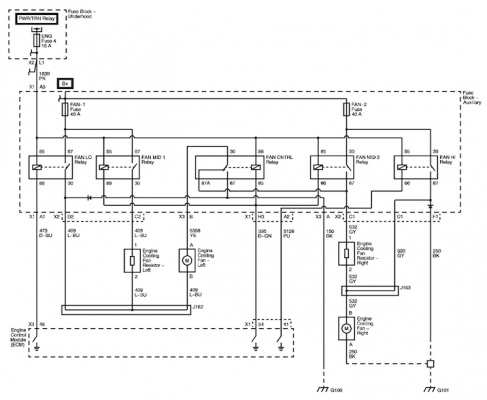And here's a description of operation:
Cooling Fan Description and Operation (Gas)
Cooling Fan Control w/o HP2
System Overview
The engine cooling fan system consists of 2 electric cooling fans and 3 fan relays. The cooling fan relays are arranged in a series/parallel (S/P) configuration. This allows the engine control module (ECM) to operate both fans together at low or high speeds using 2 fan control circuits. The cooling fans receive positive voltage from the cooling fan relays, which receive battery positive voltage from the underhood fuse block. The cooling fans are supplied a ground at G100 and G101.
Low Speed Operation
The ECM applies ground to the coil side of the cooling fan low speed relay. This energizes the coil and applies voltage directly to the left cooling fan through the switch side of the low speed relay. The left cooling fan is connected in series to the right cooling fan through the de-energized series/parallel (S/P) cooling fan speed control relay. The result is a series circuit that operates both fans at low speed.
High Speed Operation
The ECM applies a ground to the coil side of the cooling fan low speed relay, the S/P cooling fan speed control relay, and the cooling fan high speed relay. When energized, the high speed fan relay applies voltage directly to the right cooling fan through the switch side of the relay. Simultaneously, the low speed fan relay and the S/P speed control relay provide ignition voltage and a direct path to ground for the left cooling fan. During high speed fan operation, both engine cooling fans have their own ground path. The result is a parallel circuit with both fans operating at high speed.
Cooling Fan Control w/ HP2
System Overview
The hybrid engine cooling fan system consists of two electrical cooling fans, two resistors, three engine control module (ECM) fan output control drivers, and five fan relays. The relays are arranged in a series/parallel configuration that allows the ECM to operate the fans at low, medium, or high speed depending on engine cooling requirements. The ECM controls the five relays by grounding the relay control circuits.
Low Speed Operation
The ECM applies a ground to the fan 1 control circuit for the low fan relay. This energizes the low fan relay coil, closes the relay contacts, and supplies battery positive voltage from the fan 1 fuse through the cooling fan motor supply voltage circuit to the left cooling fan. The ground path for the left cooling fan is through the de-energized fan control relay, through the right cooling fan in-line resistor, and right cooling fan. The result is a series circuit with both fans running at a reduced speed.
Medium Speed Operation
The ECM applies a ground to the fan 2 control circuit, which energizes a bank of three relays consisting of the FAN Mid 1 relay, the fan control relay, and the FAN Mid 2 relay. When these three relays are energized the Mid 1 relay supplies battery voltage to the left cooling fan through the left cooling fan resistor. A direct ground path is provided for the left fan through the energized fan control relay. At the same time the Mid 2 relay is energized which applies battery voltage to the right cooling fan through the right cooling fan resistor. The result is a parallel circuit where each fan has voltage applied through a separate resistor, causing each fan to operate at a medium speed.
High Speed Operation
The ECM applies a ground to the fan 1, fan 2, and fan 3 relay control circuits simultaneously, which activates all five relays. This allows battery voltage to be applied directly to the right cooling fan from the Fan High relay, and battery voltage to be applied directly to the left fan from the Fan Low relay. The left fan is supplied a direct path to ground through the energized fan control relay. This arrangement provides each fan with direct battery voltage and its own ground path. The result is a parallel circuit with both fans running at full speed. When the ECM is commanding a fan relay ON, the voltage of the control circuit should be low, near 0 volts. When the ECM is commanding a fan relay OFF, the voltage of the control circuit should be high, near battery voltage.

